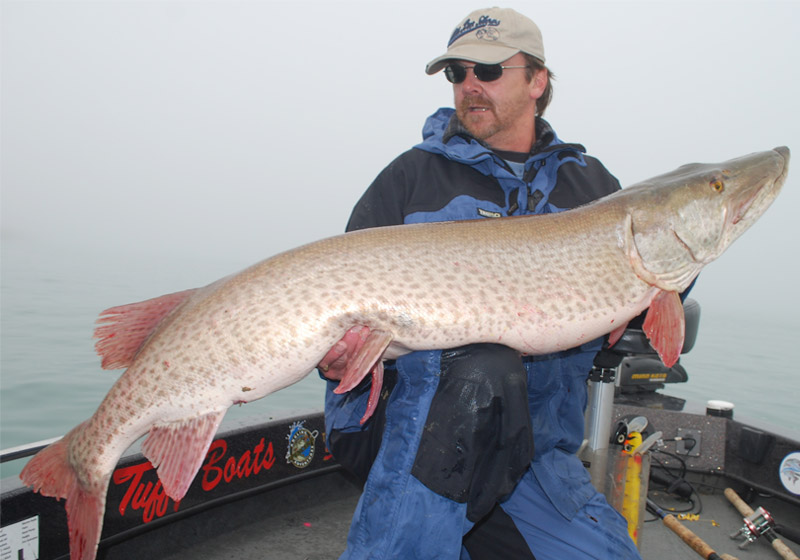Lake St. Clair Fishing Guide Part 1

It is a long-known truth that musky lakes tend to come and go in the eyes of the musky fisherman, as they seem to peak and decline in their ability to produce large quantities of big fish. Because of this, we as anglers are always asking ourselves where the hot lake is right now. At this moment, however, I can pretty much promise you that if you inquire with people in the musky world the overwhelming response for the current hot spot will be Lake St. Clair, Michigan.
Lake St. Clair, however, is not a new musky fishery as so many other hot musky waters are, such as Mille Lacs, Vermilion or Green Bay. These all seem to peak out just after the newly stocked fish start reaching their full growth potential. St Clair, on the other hand, has all-natural Great Lakes strain muskies that have been in the lake forever. So the obvious question becomes why now? The reasons for this are not only extremely numerous but also particularly interesting. This article has been broken up into two separate parts. The first portion deals with the layout of the lake and the biology behind Lake St. Clair's rise to the top of the musky fisherman's want list. The second part deals with how these changes have impacted the fishing, and how you as anglers can successfully catch muskies on this magnificent piece of water.
The History
It is true that all fisheries do go in cycles with peaks and valleys in the fishing, as well as slight changes in their overall biological makeup. Lake St. Clair, on the other hand, is one of those lakes which in the last 60 years have had complete overhauls in the lakes makeup, biology and fishing. It is documented that before the Michigan area began to be heavily logged and then farmed, Lake St. Clair was a fairly clear system. However, once the lakes watershed, the land area from which water drains into a lake, began to be heavily farmed and the trees were no longer around to stop erosion and thus sediment-filled water flowed into the lake. This huge increase in sediment in the water run off caused the lake to lose the waters clarity and become much more turbid (dirty). Then through the mid 1900’s the use of powerful chemical fertilizers was discovered. These chemicals flowed freely into the lake causing a boom in algae growth. This algae combined with the already sediment-rich water caused Lake St. Clair to be known as an extremely dirty lake providing extremely low water visibility rates. In 1972, however, the Clean Water Act was passed which greatly reduced the chemical content that could be put into the lake from runoff or otherwise. This caused a slow but noticeable amount of cleaning to occur in the lake and it became increasingly clear. Then in 1998 the proverbial bomb shell hit: Quagga and Zebra mussels where introduced. Both of these mussels are extremely effective filter feeders with very high reproduction rates. There affect was astonishing. Within a few years the lakes water cleared up dramatically, and the mussels are considered to be one of the largest reasons that Lake St. Clair maintains a visibility which frequently exceeds 6 foot.
The effects this new cleaner water had on Lake St. Clair were numerous. First as the water became clearer it allowed for much more sunlight penetration in the water. This in turn allowed weed growth in the lake to skyrocket. In a study conducted by the Ontario Ministry of Natural Resources they show a 500% increase in plant growth from 1978 to 1994. Although another study has, not to my knowledge, been conducted many biologists speculate that since 1994 the weed growth has probably gone up another 500 or so percent due to the increase in water clarity since the first study.
One drawback to this water cleaning and the addition of more weed growth was a large reduction in the lakes walleye population. Walleye thrive best in more stained water due to its higher population of zooplankton. The walleye fry feed on the zooplankton and thus the lower levels have had a large effect on the survival rates of the walleye fry. This caused a huge decrease in the population levels of the Thames River walleye stock which was the main source of the lakes walleye. Today St. Clair still maintains a good, but reduced, walleye population. Most of its fish today are actually fish that have migrated up from Lake Erie.
On the flip side, the muskellunge population performs much better when the water is cleaner. The addition of weeds and clearer water not only increases their habitat, but it also greatly increases their reproduction rates. As these reproduction rates increased, as well as the habitat, we saw an already world-renowned musky fishery improve greatly.
As a person who is primarily concerned with catching muskies, it is very easy to consider this to be pointless information; however that could not be further from the truth. By giving yourself a proper understanding of how these changes have effected both the musky population and the lake itself, you will be not only a better student of the environment but also a much better angler. In addition although this information is specific to Lake St. Clair's history there are a number of other lakes who have gone through similar changes and thus this information could be useful to those lakes as well.
Since 2000
In the early 2000’s we saw the musky population of the lake increasing. However there was one main problem, the girths on the fish that were being caught were a bit less than desired. Although a large number of fish grew to 25-30 pounds, the 40 and 50 pound marks seemed to be outside of the question. This problem had a couple primary causes. First of all was the lakes lack of forage to feed all of the muskies in it. Although Lake St. Clair did have enough forage to keep the musky population fed and relatively healthy, it did not have enough food to keep the fish fed easily. As is true with humans, if you eat enough to stay alive and also exert an equal amount of energy you will have a lean and healthy figure. However, if you have little effort tracking down your food and therefore exert little effort during your day while eating sufficiently you will have a rather hefty figure. In fishing terms this means the muskies in the lake all had enough to eat, however they did have to work very hard for their food and therefore had to burn a lot of calories to get it. In this period the primary food source of muskies was perch. Although perch are a good food source for muskies they do have a number of drawbacks. First of all, Lake St. Clair receives a massive amount of perch fishing pressure from anglers. In fact, in the years of 2002 to 2005 the Michigan Department of Natural resources estimated that about 750,000 perch were harvested per year by Michigan anglers alone. Considering that Lake St. Clair is nearly two thirds in Ontario and a similar harvest can be expected from their anglers as well, it is fair to say that a ton of perch are being harvested by perch anglers every year. Perch anglers are extremely good at targeting and only harvesting the larger fish in the population, normally nine plus inches in length. This heavy targeting of the larger fish skews the population demographic of the perch in the lake toward the small to medium fish. From a muskies food perspective that means that its primary forage is a population of small to medium length perch, which due to their size and relatively low oil content, do not provide the most high fat diet. This causes the muskies to require more fish per day to stay healthy, thus forcing them to exert more energy to catch their food.
In 2003 the first ever discovered VHS, Viral Hemorrhagic Septicemia, infected great lakes fish was discovered, a musky from Lake St. Clair. During the mid-2000’s the virus took a tremendous toll on the musky population of the lake, killing as high as 40-50% of the muskies in the system. Although the immediate results on the fishery seemed horrible, the virus turned out to be one of the greatest things to have ever happened to Lake St. Clair musky fishing. First of all, as is true with any virus it is more lethal to fish with a more compromised immune system. Therefore the virus had a much higher mortality rate on fish that were malnourished, sick, weak or otherwise not completely healthy. More or less we saw an extreme example of natural selection thinning out an already over populated, population of muskies. As is true with any virus, the first two years after being introduced it had its most lethal effect on the population. Each subsequent year, as more fish became immune to it and the sick and weak fish were killed off, it became much less lethal. By the late 2000’s it had pretty much run its course and the remaining population is mostly immune and therefore not really affected. What the virus did by killing off the weaker members of the musky population in much higher quantities then the healthy fish is allow for an huge overall genetic improvement in the musky strain. Basically leaving us with only the strongest fish left to procreate.
Another huge change we have seen in the lake over the last 10 years is the population of gizzard shad. Although gizzard shad have always existed in Lake St. Clair, their numbers right now are the highest they have ever been. When the virus hit the lake it greatly reduced the population of the gizzard shads primary predator, muskies. This reduction in predators triggered a gradual increase in the shad population on the lake. The major limiting factor to gizzard shad populations on the lake however has always been winter die off. Lake St. Clair is located at the northern most extreme of the gizzard shads range. This is because a shads body is not capable of handling long periods in cold water such as is seen in northern winters. What will happen is that a gizzard shads body will actually shut off completely when it is exposed to a long period of cold water temperature. It results in their bodies being incapable of processing their own fat reserves and the fish starve even though they have fat reserves. On Lake St. Clair this process combined with the muskies predation has always served to keep the gizzard shads overall population down. However, just as the virus was finishing up its work on reducing the musky population we had a number of years with exceedingly warm winters. These mild winters (not every winter but a number of them over the last several) have allowed more and more shad to survive the winter. As we all know when you let a fish with reproduction rates as high as that of a shad get the ball rolling their numbers explode. From 2006-2010 the Ontario Ministry of Natural Resources conducted a survey on the shad population of the south shore of the lake and they discovered that the population showed a huge increase over that time. Nearly three times as many shad were caught in their survey nets in 2010 than ever before.
This explosion in the shad population of the lakes has given the muskies not only another food source, but also a food source which is extremely well suited for growing large fat muskies. Gizzard shad tend to average between 6-12 inches in length and can easily exceed 16 inches. Their very round, or dinner plate body design however makes them more substantial than a leaner fish such as a perch of the same length. In addition, gizzard shad are also fish that are extremely rich in oils and fat making them a very high protein, fattening meal for muskies. When you combine that with the huge numbers that gizzard shad schools usually contain it makes it easy for muskies to catch them with little effort, and you are left with a perfect food source to grow big muskies. Combine this greatly increased shad population with the already high perch population, in addition to the number of other less used forage fish such as walleye, white bass, catfish, sheephead, etc. and you are left with an extremely well rounded musky forage base perfectly designed to produce not only lots of muskies but fat fish as well.
The last major factor to the recent explosion in the musky fishing we see on Lake St. Clair is due to a change by the anglers. In 2004 we saw the introduction of the use of live wells in boats as a means of reviving fish before releasing them. In the past, trollers would fight larger fish for normally 30 plus minutes while the boat was moving away from the fish at around 3 miles an hour. Then the fish was netted and dropped on the deck. After being unhooked and photographed, all while out of water, the fish was then dropped over the side of the boat. The larger boats which used this method did not give anglers the chance to properly revive the fish in addition to the boat being unable to stop for such a thing since that would only tangle up their spread of 8-16 lines. This caused large mortality especially on larger fish who normally had taken longer to catch and photograph. This evolution is summed up nicely by top trolling charter Captain Jason Quintano when he said:
“Lake St. Clair sees the majority of its fishing pressure from large trolling boats, typically 20’ to 30’ cabin cruisers and due to the style of trolling utilized with the big planer boards you cannot just stop your boat without bringing your entire set in. Before the addition of live wells we were forced to release fish by simply leaning over the side of the boat and drag them till they swam away. The intentions were good but it was tough on the fish. Now with the FISHThANKS and similar live wells we pump fresh water from our wash downs into a 56” live wells and then when the fish is swimming on their own we release them. Dave Clark’s design is now used by the majority of troller’s here on Lake Saint Clair and you shouldn’t be trolling without a FISH ThANKS or some sort of live well that allows the fish time to recuperate.” With the addition of these new live wells we have seen the once relatively (when compared to traditional angling) high mortality rates of fish go down tremendously especially on the larger fish.
As I mentioned at the beginning of the article this piece is part of a two part series. In this first article I talk about the changes the lake has undergone as well as the biology that we see driving and causing these changes. The next part will appear in the next issue of Musky Hunter and will deal with how these changes have transformed the fishing on Lake St. Clair and how you should go about fishing the lake now in order to assure the greatest success. Also, because this first article is a biology article I think it is important to tell you where most of the information came from. Due to the lack of sufficient research on the actual fishing and total fish records of Lake St. Clair a handful of these numbers have a fair amount of speculation in them. However, I was able to get into contact with a couple of the head biologists from both the Michigan and Ontario side of the lake in order to pick their brains and get all the firm data they had available; such as the perch and walleye harvest numbers, in addition to their speculation on things like the total VHS kill rate on muskies and the shad population. I then combined this info with the fishing data from a couple of top guides on the lake such as Captain Jason Quintano and myself to fill in more of the blanks using our fishing data.
Hopefully, this information helps you to understand how a body of water such as Lake St. Clair functions. Also, keep in mind that these concepts can also be applied to help you to better understand the histories of your local bodies of water so that you are able to fish them much more effectively.
HOURS
Monday
7:00am - 8:00pm
Tuesday
7:00am - 8:00pm
Wednesday
7:00am - 8:00pm
Thursday
7:00am - 8:00pm
Friday
7:00am - 8:00pm
Sat. & Sun.
7:00am - 8:00pm
Spencer's Angling Adventures
29474 Old North River Road
Harrison Township, MI 48045
(419) 410-0498


